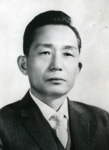From Wikipedia, the free encyclopedia
Republic of Korea presidential election, 1971
Map of pluralities won in provinces and cities:
■ – Park Chung Hee
■ – Kim Dae-jung
Presidential elections were held in South Korea on 27 April 1971.[ 1] Park Chung-hee , who won 53.2% of the vote. Voter turnout was 79.8%.[ 2] Yushin Constitution . The military retained control until June 1987.
Results
Candidate
Party
Votes
%
Park Chung-hee Democratic Republican Party 6,342,828
53.2
Kim Dae-jung New Democratic Party 5,395,900
45.3
Jin Bok-ki People's Party 122,914
1.0
Park Ki-chul Democratic Nationalist Party 43,753
0.4
Lee Jong-yun Liberal Democratic Party 17,823
0.1
Invalid/blank votes
494,606
–
Total 12,417,824 100
Source: Nohlen et al.
Provincial results
Province or city
Park Chung Hee
Kim Dae-jung
Jin Bok-ki
Park Ki-chul
Lee Jong-yun
Total
Votes
%
Votes
%
Votes
%
Votes
%
Votes
%
Seoul
805,772
(40.0%)
1,198,018
(59.4%)
6,881
(0.3%)
4,811
(0.2%)
1,426
(0.1%)
2,016,098
Gyeonggi
687,985
(48.9%)
696,582
(49.5%)
13,770
(1.0%)
6,547
(0.5%)
2,995
(0.2%)
1,407,879
Gangweon
502,722
(60.0%)
325,556
(38.8%)
7,326
(0.9%)
2,985
(0.4%)
1,390
(0.2%)
839,979
Chungnam
556,632
(53.5%)
461,978
(44.4%)
14,411
(1.4%)
5,285
(0.5%)
2,322
(0.2%)
1,040,628
Chungbuk
312,744
(57.3%)
222,106
(40.7%)
6,989
(1.3%)
2,662
(0.5%)
1,154
(0.2%)
545,655
Jeonnam
479,737
(34.4%)
874,974
(62.8%)
31,986
(2.3%)
4,362
(0.3%)
2,122
(0.2%)
1,393,181
Jeonbuk
308,850
(35.5%)
535,519
(61.5%)
21,162
(2.4%)
3,167
(0.4%)
1,646
(0.2%)
870,344
Busan
385,999
(55.7%)
302,452
(43.6%)
1,974
(0.3%)
2,518
(0.4%)
583
(0.1%)
693,526
Gyeongnam
891,119
(73.4%)
310,595
(25.6%)
6,793
(0.6%)
4,580
(0.4%)
1,634
(0.1%)
1,214,721
Gyeongbuk
1,333,051
(75.6%)
411,116
(23.3%)
9,838
(0.6%)
6,438
(0.4%)
2,374
(0.1%)
1,762,817
Jeju
78,217
(56.9%)
57,004
(41.4%)
1,784
(1.3%)
398
(0.3%)
177
(0.1%)
137,580
References
^ Dieter Nohlen , Florian Grotz & Christof Hartmann (2001) Elections in Asia: A data handbook, Volume II , p420 ISBN 0-19-924959-8^ Nohlen et al., p465














